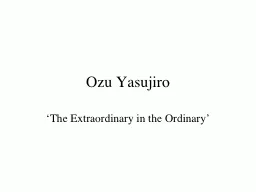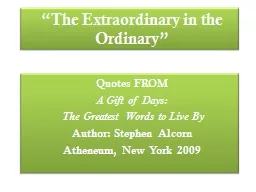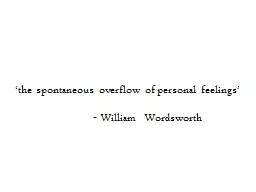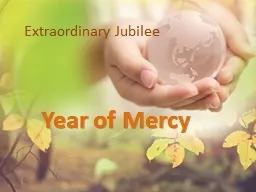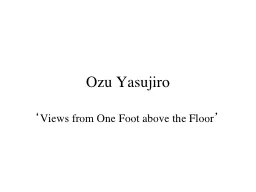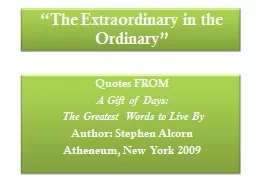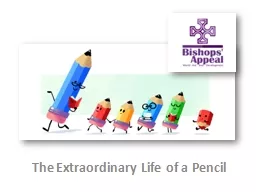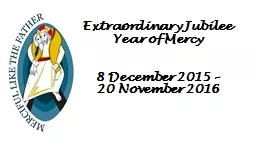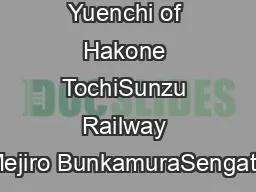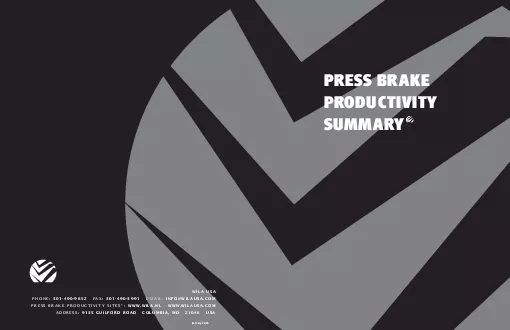PPT-Ozu Yasujiro ‘The Extraordinary in the Ordinary’
Author : cleminal | Published Date : 2020-08-29
Very Short Biography Ozu Yasujiro b in Tokyo 12 December 1903 d in Tokyo 12 December 1963 Born as a son of the head clerk of a wealthy merchant Brought up in
Presentation Embed Code
Download Presentation
Download Presentation The PPT/PDF document "Ozu Yasujiro ‘The Extraordinary in the..." is the property of its rightful owner. Permission is granted to download and print the materials on this website for personal, non-commercial use only, and to display it on your personal computer provided you do not modify the materials and that you retain all copyright notices contained in the materials. By downloading content from our website, you accept the terms of this agreement.
Ozu Yasujiro ‘The Extraordinary in the Ordinary’: Transcript
Very Short Biography Ozu Yasujiro b in Tokyo 12 December 1903 d in Tokyo 12 December 1963 Born as a son of the head clerk of a wealthy merchant Brought up in Matsuzaka where his father comes from. 360 Assessment. Certification. Facilitator: (Add name). © Zenger Folkman 2015 - ELAC51.3.1. 2. Workshop Objective. Prepare you to hold . Extraordinary . Leader coaching conversations . that will help . Presented at . Mainline Association for . Continuing Education at. Great Valley, PA on. March 19, 2015 by. Joel Wagoner, CPA, CMA, CFM. Assistant Professor. DeSales University. Goodbye Extraordinary Items. Quotes FROM . A Gift of Days:. The Greatest Words to Live By. Author: Stephen Alcorn. Atheneum, New York 2009. The Extraordinary in the Ordinary . (q. uote 1). “When you do the common things of life in an uncommon way, you will command the attention of the world.”. by Mary Erickson Ph.D. . Education Consultant & Professor of Art. with Ellen Murray . Meissinger. . Artist & Professor of Art and her students at Arizona State University. International Guild . - William Wordsworth. Romanticism. :. * 1789 French Revolution, Reign of Terror. Influenced reaction in Britain.. * France/Netherlands (1793), engages Britain in 25 year struggle.. * Napoleonic Wars (Horatio Nelson), Battle of Trafalgar 1805.. Year of Mercy. What is Jubilee? . Called every 50 years or when needed. In scripture time to rebalance relationships & refocus on the kind of society that should be for the flourishing of all . Jubilee in scripture… . ‘. Views from One Foot above the Floor. ’. Ozu as auteur. Complete control of film-making in every stage. The condition for being an auteur. Ozu. wrote all his late scripts with Noda . Kogo. and gave meticulous and final instructions on. Conception Vessel (CV). Or . Ren. Mai Meridian . Resources. Pictorial Atlas p 282-299. Yin yang house website. http://www.yinyanghouse.com/acupuncturepoints/conceptionvessel_meridian_graphic. Ren. Mai . Quotes FROM . A Gift of Days:. The Greatest Words to Live By. Author: Stephen Alcorn. Atheneum, New York 2009. The Extraordinary in the Ordinary . (q. uote 1). “When you do the common things of life in an uncommon way, you will command the attention of the world.”. Where does your pencil come from?. One tree..... From the Sierra Nevada produces 170,000 pencils.. Apart from Californian Cedar Wood you need.... Brazilian Graphite. Thai Rubber. Chinese Aluminium. The humble pencil is globally interconnected!. 8 December 2015 – . 20 November 2016. What is a holy year?. Every 25 years the Pope announces a ‘Holy Year’. . Holy Years . include . special celebrations and . pilgrimages. They . offer . special . La gamme de thé MORPHEE vise toute générations recherchant le sommeil paisible tant désiré et non procuré par tout types de médicaments. Essentiellement composé de feuille de morphine, ce thé vous assurera d’un rétablissement digne d’un voyage sur . Sales of Mejiro Oizumi and Kodaira Numazu Teishajo-mae–Mishima- Youkaichi sections openYoukaichi–Hino–Takamiya–Taga Hakone Tochi Hakone Yusen Hakone Tochi acquires Hakone Yusen Postcard for S WILA USA PHONE301-490-9652 FAX301-490-3991 INFOWILAUSACOMPRESS BRAKE PRODUCTIVITY SITESWWWWILANL WWWWILAUSACOMADDRESS9135 GUILFORD ROAD COLUMBIA MD 21046 USA January 2006your press brakes
Download Document
Here is the link to download the presentation.
"Ozu Yasujiro ‘The Extraordinary in the Ordinary’"The content belongs to its owner. You may download and print it for personal use, without modification, and keep all copyright notices. By downloading, you agree to these terms.
Related Documents

